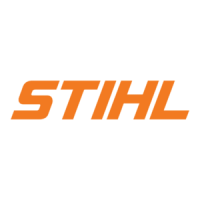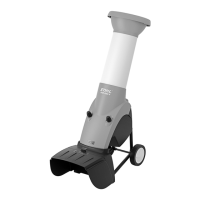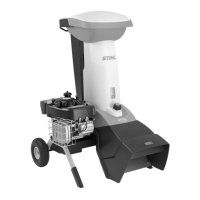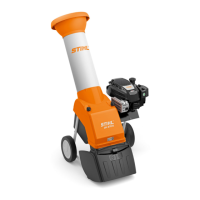39
DEFRNLITESPTNOSVFIDAPLSLSKHU EN
0478 201 9913 B - EN
● Push the quick fastener (H) onto the
wheel axle with the convex side facing
outwards.
● Press wheel caps (J) onto wheels.
7.2 Installing the chassis and
ejection chute
1 Install the ejection chute
extension
● Place the basic unit (A) onto a block of
wood with a height of approx. 15-
20 cm.
● Engage the hooks (1) of the ejection
chute extension (O) into the
openings (2) on the rear of the basic
unit (A) and turn the extension
downwards so that the front part of the
basic unit is precisely inserted in the
opening of the ejection chute extension.
● Fasten the screws (U) in the lugs of the
hooks (1) (1 - 2Nm).
2 Attach the chassis
● Press square nuts (K) and washers (L)
in the recesses provided on the basic
unit (3).
● Push the chassis with both wheel
carriers (4) up to the stop in the guides
on the basic unit (5).
● Push bent section of wheel carrier (6)
into the recess on the ejection chute
extension (7).
● Insert the screws (M) with washers (L)
the openings in the wheel carriers (8)
and fasten using combination
spanner (V) (4 - 6Nm).
3 Install strip
● Position the strip (P) and fasten
screws (R) (1 - 2Nm).
● Lift machine into upright position.
4 Install the discharge flap
● Attach the discharge flap (N) and press
in pin (Q) (use a plastic hammer if
necessary).
Ensure that the ribs (9) inside the
discharge flap on the left and right are
all correctly located in the guide groove
of the ejection chute extension (10).
7.3 Opening and closing the
discharge flap
Opening the discharge flap:
● For shredding, fold the discharge
flap (1) upwards and allow the tab (2) to
engage in the ejection chute extension.
Closing the discharge flap:
● For transport or space-saving storage,
lift the tab (2) slightly and fold away the
discharge flap (1) downwards.
7.4 Attaching the upper chute
● Place upper chute (S) with symbol (1)
facing forwards in the direction of
closure screws (2) on lower chute (3).
● Screw in screws (T) in the sequence
shown (1 2 3 4).
8.1 What material can be processed?
– Feeding the garden shredder. (Ö 8.8)
GHE 150, GHE 250 S, GHE 260 S:
Tree and hedge cuttings as well as thick
branch material with side shoots.
GHE 250, GHE 260:
Organic plant trimmings such as fruit and
vegetable cuttings, flower cuttings, leaves,
tree and hedge cuttings, as well as thick
branches with side shoots and twigs.
8.2 What material cannot be
processed?
Stones, glass, bits of metal (wire, nails,
etc.) or plastic must not be fed into the
garden shredder.
As a general rule:
Any materials that do not belong on the
compost heap should not be processed
using the garden shredder.
4
The bent section of the wheel
carrier (6) must be precisely
inserted in the recesses on the
ejection chute extension (7).
The chute can only be installed by a
specialist dealer using special
tools. STIHL recommends STIHL
specialist dealers.
5
6
We recommend following the
described installation sequence to
prevent the splash guard slipping
off when screwing in the screws.
8. Notes on working with the
machine
Tree and hedge cuttings should be
processed when fresh, as the
shredding performance is better
with fresh than with dried-out or wet
material.

